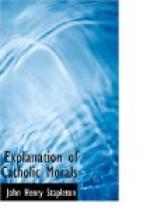The craft found favor with the pagans and flourished many years before the Christian era. Wondrous things were wrought by the so-called pythonic spirit; evidently outside the natural order, still more evidently not by the agency of God, and of a certainty through the secret workings of the “Old Boy” himself. It was called Necromancy, or the Black Art. It had attractions for the Jews and they yielded to some extent to the temptation of consulting the Python. For this reason Moses condemned the evil as an abomination. These are his words, taken from Deuteronomy:
“Neither let there be found among you any one that consulteth soothsayers, or observeth dreams and omens; neither let there be any wizard, nor charmer, nor any one that consulteth pythonic spirits or fortune tellers, or that seeketh the truth from the dead. For the Lord abhorreth all these things; and for these abominations He will destroy them.”
The Black Art had its votaries during the Middle Ages and kept the Church busy warning the faithful against its dangers and its evils. Even so great a name as that of Albert the Great has been associated with the dark doings of the wizard, because, no doubt, of the marvelous fruits of his genius and deep learning, which the ignorant believed impossible to mere human agency. As witchcraft, it nourished during the sixteenth and seventeenth centuries. The excesses to which it gave rise caused severe laws to be enacted against it and stringent measures were taken to suppress it. Many were put to death, sometimes after the most cruel tortures. As is usually the case, the innocent suffered with the guilty. The history of the early New England settlers makes good reading on the subject.
Some people claim that the spiritism of to-day is only a revival of old-time witchery and necromancy, that it is as prevalent now as it was then, perhaps more prevalent. “Only,” as Father Lambert remarks, “the witch of to-day instead of going to the stake as formerly, goes about as Madam So-and-So, and is duly advertised in our enlightened press as the great and renowned seeress or clairvoyant, late from the court of the Akoorid of Swat, more recently from the Sublime Porte, where she was in consultation with the Sultan of Turkey, and more recently still from the principal courts of Europe. As her stay in the city will be brief, those who wish to know the past or future or wish to communicate with deceased friends, are advised to call on her soon. Witchcraft is as prevalent as it ever was, and the witches are as real. They may not have cats on their shoulders or pointed caps, or broomsticks for quick transit, but they differ from the witches of the past only in being liberally paid, instead of liberally punished.”
The Church does not deny the possibility of intercourse between the living and the souls of the dead; she goes farther and admits the fact that such intercourse has taken place, pointing, as well she may, to the Scriptures themselves wherein such facts are recorded. The lives of her saints are not without proof that this world may communicate with the unknown. And this belief forms the groundwork, furnishes the basic principles, of Spiritism.




